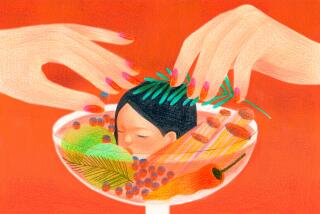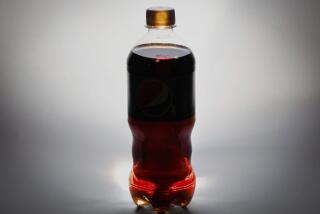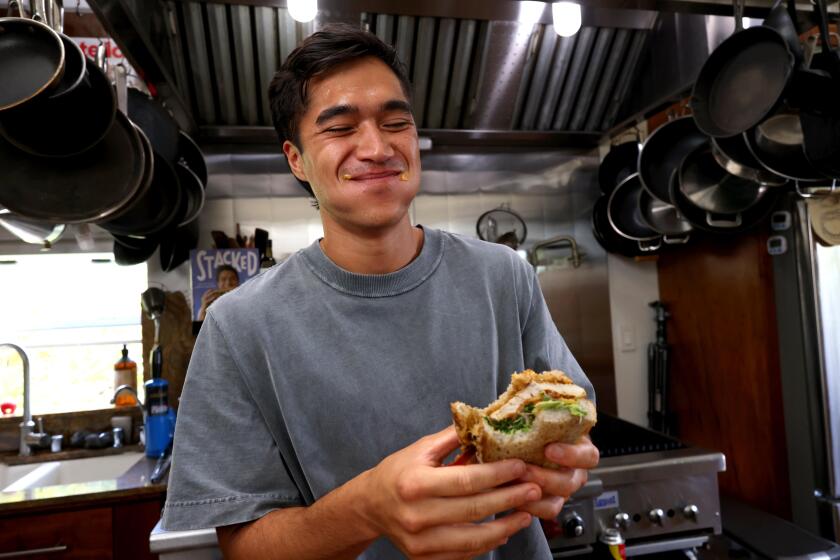Taking the Sugar Out of Sweet
CHICAGO — Midway through the afternoon, when the belly yearns for snacks, three NutraSweet executives are going wild: cola, orange drink, citrus punch, chocolate milk, more cola, pound cake and crispy squares of coconut pie -- all test-kitchen concoctions made with artificial sweeteners.
They consume two servings of everything. In quick succession.
They wax exuberant about one of the pound cakes -- moist, crumbly and nicely browned.
“The person who cooked these said she never had such browning before,” says Craig R. Petray, chief executive of NutraSweet Co.
In the bounty of goodies before them lies a vision of the future of sweetness -- a future, these executives hope, just as sweet and delectable as real sugar.
But, as researchers have discovered, the quest to find a perfect, consequence-free artificial sweetener is difficult, littered with cloying, metallic and just plain odd-tasting chemicals.
Today, the research is receiving fresh attention -- fueled by an expanding national waistline. Nutritionists believe that Americans’ breathtaking intake of sugars in soft drinks and processed foods is partly to blame.
The U.S. Department of Agriculture estimates that the average American eats about 100 pounds of added sugars a year, up 30% since the 1980s.
Consumers are taking note, trying in small ways to clean up their act. Diet soft drink sales are growing at about 6% a year, while those of regular soft drinks are declining by as much as 2%.
After years of loading snacks with sugar, food manufacturers are developing more reduced-sugar brands so that consumers can have their cake and eat it.
To tackle the problem, some are cutting down slightly on sugar in their products, or artfully combining high-intensity artificial sweeteners to find just the right combinations to mimic real sugar.
Other companies are turning to the latest research in genetics and chemistry. Now there are humming labs, seeking out “enhancer” chemicals that accentuate the effects of real sugar, thus allowing less to be used.
Shaving away sugar is no easy business.
Sugar does much more than sweeten. It provides crumbliness to a cake’s interior, crispness to its outside and a richer taste to a soft drink.
Despite decades of research, artificial sweeteners -- a $1-billion-a-year market in the U.S. -- still taste noticeably unnatural.
“You could probably line up 30 different sweeteners and I could tell you what each one was, no problem,” says Susan Schiffman, a sweetness researcher at Duke University Medical Center.
*
The human lust for sweetness runs deep. Even newborn babies have an innate love of sugar-flavored water.
There is a sensible evolutionary reason for this: Sugar means fuel -- 15 calories in each teaspoon. Homing in on rich sources in nature -- fruits, berries, honey -- is a key for creatures as varied as flies, birds and dogs.
Unlike the super-sharp sensors for pheromones and poisons, human sweet receptors are naturally blunt so that people only notice significant sources of calories. As for sugar, the more the better.
It’s an instinct that proved useful back when calories were scarce. It is far less beneficial in a land flowing with candy, super-sized soft drinks and doughnuts.
A problem with cutting sugar is that its sweetness is tricky to imitate.
Artificial sweeteners stick to the same receptor but to different parts, and with different speeds and tightness. Those factors translate into subtle differences in onset of taste, intensity and length of sweetness.
Sweetness aficionados have developed discerning palates.
“I can pick each one up and say, ‘Ah, Ace-K ... ah, sugar ... ah, thaumatin,’ ” Schiffman says.
*
The first artificial sweetener was found in 1879 by accident.
Two chemists at Johns Hopkins University, Constantine Fahlberg and Ira Remsen, were trying to make new chemical dyes from coal tar derivatives when a vessel boiled over in the lab one day. Fahlberg failed to properly wash his hands before a meal and noted how sweet his fingers tasted.
He traced the sweetness back to a two-ringed chemical called benzoic acid sulfanilamide. Fully 300 times sweeter than sugar, it is indigestible by the body, and thus calorie-free. He later dubbed the chemical saccharin, from saccharum, the Latin word for sugar.
The pattern of serendipity has continued up until today.
Cyclamate, used in soft drinks until it was banned, was discovered in 1937 when University of Illinois graduate student Michael Sveda put his cigarette down near a compound he was testing as a possible anti-fever drug and later noticed he was smoking a sweet cigarette.
Aspartame was discovered in 1965 by chemist Jim Schlatter, who licked his finger while testing a new anti-ulcer drug for the pharmaceutical company G. D. Searle & Co.
Scientists now know of scores of sweet chemicals -- monellin, stevioside, thaumatin, lugduname, glycyrrhizin, maltitol and the tasty but toxic dulcin, which was used as a sweetener during World War I (and poisoned several children).
Only a handful have been approved by the Food and Drug Administration for use as sweeteners: saccharin (most commonly known by the ubiquitous pink Sweet’N Low packets); acesulfame K (a less-known saccharin-like chemical); aspartame (in Diet Coke and Pepsi and the little blue packets of Equal); sucralose (in yellow Splenda packets); and neotame, the most recently discovered sweetener, more than 7,000 times sweeter than sugar.
From the moment the first sweetener was discovered, the sugar industry sensed a threat.
In the early 20th century, the European sugar beet industry persuaded several countries to make the inexpensive saccharin available only by prescription.
A cartel of saccharin smugglers sprang up in response, sneaking the synthetic white powder over the Swiss border inside car tires, false-bottom suitcases, waistcoats, candles and bottles of champagne.
*
It was just the first scuffle to break out in the world of artificial sweetness.
The latest centers on sucralose, which has seized about 50% of the packet artificial sweetener market in the U.S. during the past four years under the brand name Splenda.
Baking is at the heart of the conflict.
Sucralose -- 600 times sweeter than sugar -- was discovered in 1976 as chemists working for Britain’s sugar maker Tate & Lyle searched for new uses for sucrose. They altered it to contain three atoms of chlorine.
Its intense sweetness was discovered, company legend goes, when a graduate student misunderstood instructions to “test” it, and “tasted” it instead.
As it turned out, the addition of the chlorine atoms rendered the compound indigestible, and thus calorie-free.
Splenda lacks saccharin’s bitterness and aspartame’s heat-fragility. The latter means it can be used in baking, putting it in direct competition with sugar.
But Splenda still falls short -- because foods depend on sugar for more than just sweetness. In baked goods, sugar stops flour and water from reacting together to form long stringy threads of gluten. This enables cookies and pie crusts and cakes to be tender and crumbly instead of bread-like and doughy.
When heated, sugar combines with amino acids in a process known as the Maillard reaction -- imparting crispness and color. It also adds bulk and moisture to baked goods: Remove it and you must add something else or face a culinary disaster.
Splenda’s maker touts its closeness to the real thing and has been gradually building market share using the advertising slogan “Made from sugar so it tastes like sugar.”
The campaign has angered its competitors. While Splenda, they say, may start its life as sugar, the chlorine-studded chemical is anything but. Thus, they say, its marketing is deceptive.
Lawsuits have been filed against the company that markets Splenda, McNeil Nutritionals. Among those suing are the Sugar Assn. and Merisant Co., purveyors of Equal.
The Sugar Assn. has also sponsored a website, www.truthaboutsplenda.com, to challenge Splenda’s advertising and safety.
McNeil Nutritionals has responded with its own lawsuit against the Sugar Assn.
“Sucralose is in fact made from sugar, and it does taste like sugar,” McNeil spokeswoman Cathy Grayson-Roper said.
*
The problems in removing sugar from products have sparked a revolution in taste science.
Could there be a way to make a little bit of sugar pack a big dollop of sweetness?
It’s an approach that has been embraced by Senomyx Inc., of La Jolla, whose research has been supported by food heavyweights Campbell Soup Co., the Coca-Cola Co. and Nestle.
Three years ago, Senomyx identified the receptor in the taste buds responsible for sweet taste -- the one to which sugar and artificial sweeteners bind to create the sweetness in cake, soda and candy.
In the company’s reception area, a picture of two mice nuzzling a berry-topped chocolate cake hangs on a wall. Nearby is an image of the sweet receptor, zig-zag in shape.
The receptor is made up of two long proteins, T1R2 and T1R3, that are stuck on the surface of cells and work together to impart sweet taste. Millions of receptors reside in the taste buds in the moist crevices of the tongue, cheek and soft palate.
Part of each receptor hangs into the mouth’s slimy void and the other end into the cell. When a sweetener binds, a message is sent into the cell’s interior and ultimately to the brain.
Senomyx is seeking needles in haystacks -- chemicals that enhance the efficiency of the sweetness receptor (or, in other projects, saltiness or savoriness).
Inside a laboratory lined with cell incubators, technicians tend to mammalian cells bathed in salmon-pink serum. The cells have been engineered to manufacture the human sweet receptor -- in effect, they are tiny fake taste buds that glow green when exposed to sugars.
In another room, machines scan 384 chemicals at a time, measuring the glow produced by each sample.
Researchers Cyril Redcrow and Poonit Kamdar watch as results come up on a screen: numbers, letters and wavy graphs that indicate how strongly the cells respond.
“Oh, see -- there’s a hit right there,” says chief scientific officer Mark Zoller, pointing to a spot where one of the wavy graphs has an extra-high peak.
Senomyx has trawled through 200,000 chemicals and found several hundred sweetness enhancer candidates.
The company is now tinkering with two, dubbed S299 and S679.
Added to food, they would make it possible to reduce sugars without adding something artificial-tasting, Zoller says.
The savings could be significant. A single can of soda with 20% less high-fructose corn syrup means about 30 fewer calories. That could add up to 10,950 calories a year -- an annual weight savings of about 3 pounds.
The savings don’t stop at the waistline.
In Chicago, among a rainbow-like product display at NutraSweet are a New Zealand beverage called Budget Pineapple and a gallon bottle of Peach Flavored Drink. Both use artificial sweeteners because they are often cheaper than sugar and high-fructose corn syrup.
In the case of some honey wheat pretzels on display, an artificial sweetener was added to cut down on honey that was clogging the manufacturer’s pretzel-extruding machine and also stopping the pretzels from rising.
NutraSweet’s Sweet Spot test kitchen is trying to combine artificial sweeteners so that one makes up for the deficiencies of the other in mimicking the precise nature of sugar.
Saccharin and Ace-K register quickly on the palate but have an after-bite of bitterness because they also bind to one of the body’s bitter receptors.
Neotame and aspartame lack bitterness but have a sweetness that takes longer to register -- and lingers unnaturally.
It is as much art as science in figuring out which combination can produce a better, more sugary taste.
Even without such blending, as much as one-third of the sugar in products can often be replaced with an artificial sweetener before consumers notice.
“Number 267 finished cleaner, with a good cola flavor at the end,” said Ihab E. Bishay, NutraSweet’s vice president for research and developing, who was sipping a small plastic beaker of the cola sample in the test kitchen, as he does several times a week.
Bishay and two other executives turn next to two chocolate milks -- one partly sweetened with neotame. They bite into two pound cakes, one reduced one-third in sugar, with sweetener taking up the slack.
The cakes are identical in taste and moisture. But the crust gives the artificially sweetened one away: It’s less crispy and crumbly.
The rich and buttery cake, loaded with fat and flour, seems to challenge some of the logic of the enterprise. Reducing sugar in foods might be a health boon -- or might possibly, like low-fat foods before them, backfire.
“It doesn’t turn the pound cake into a healthy food -- especially if you eat 30% more thinking it’s a low-calorie pound cake,” says Michael F. Jacobson, executive director of the Center for Science in the Public Interest, a Washington-based consumer group.
Nonetheless, the quest continues.
“Do I get seconds?” asks Kevin Bauer, NutraSweet’s vice president for sales and marketing, as he reaches across the table for another slice of the artificially sweetened pound cake.
*
(BEGIN TEXT OF INFOBOX)
A sweet taste
The sweet-taste receptor consists of two large proteins on the surface of taste-bud cells. When sweeteners bind, the taste buds send a signal to the brain.
Sweetness through the ages
9000 BC: Sugar cane, growing wild in New Guinea jungles, is chewed by man.
7000 BC: Neolithic cave paintings depict man harvesting honey from hives.
1000 BC: Sugar cane is traded and cultivated through the world, reaching Spain by about AD 700.
1550: First commercial cultivation of sugar cane in the New World, followed by rise of the slave trade to work plantations in Brazil and West Indies.
1879: Accidental discovery of saccharin, the first artificial sweetener.
1937: Discovery of cyclamate during studies for anti-fever drugs.
1952: First diet soft drink--a ginger ale called the No-Cal Beverage.
1963: Introduction of Tab, sweetened with saccharin and cyclamate.
1964: Diet Pepsi introduced, sweetened with saccharin.
1965: Discovery of aspartame (NutraSweet).
1966: Introduction of Fresca, sweetened with cyclamate and saccharin.
1967: Discovery of acesulfame-K, a saccharin-like artificial sweetener.
1970: Cyclamate banned in U.S. after studies report large doses can cause cancer in rats.
1970s: Introduction of high fructose corn syrup into drinks and food.
1976: Discovery of sucralose (Splenda).
1977: Food and Drug Administration proposes ban of saccharin after studies report large doses cause cancer in rats. A consumer outcry blocks the ban. Warning labels are added to saccharin-containing products.
1982: Diet Coke (sweetened with aspartame) introduced.
1992: Discovery of neotame, structurally similar to aspartame but sweeter.
1998: FDA approves sucralose (Splenda).
2000: Warning labels taken off saccharin packets.
2002: Scientists isolate human sweet-taste receptor.
2002: FDA approves the latest artificial sweetener, neotame, 7,000 to 13,000 times sweeter than sugar.
--
Sources: Coca Cola Co., PepsiCo, American Beverage Assn., Times Research
More to Read
Eat your way across L.A.
Get our weekly Tasting Notes newsletter for reviews, news and more.
You may occasionally receive promotional content from the Los Angeles Times.









